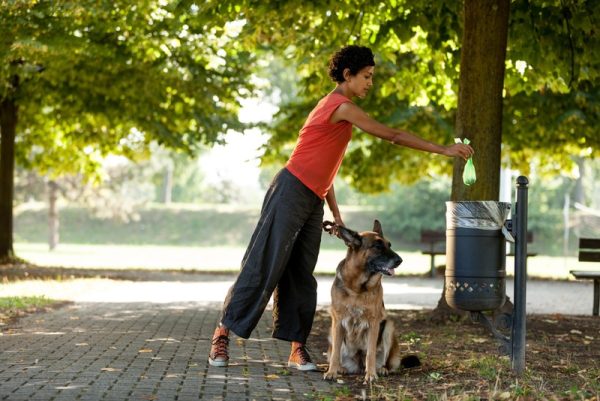When dogs develop certain unsavory behaviors, it can be very challenging for their owners to navigate. Unfortunately, it can affect the entire dynamic of a household and needs proper training or accommodations.
Bad behaviors can strain relationships long-term and is often the number one reason some families rehome their pets. So, knowing about potential challenges and how to correct them is important. Here are 10 of the most common dog behavior problems and how to help solve them.

The 10 Most Common Dog Behavior Problems
1. Chewing

Chewing can be a very problematic behavior in dogs. One of the ways that a dog learns about their world is through smell and taste, so putting things in their mouth is quite normal. For puppies, that need to chew is even more pronounced due to teething discomforts. Since chewing is a completely natural behavior, you just need to help teach your dog what they can and can’t chew on.
- Keep Belongings Put Up: While you might feel like you shouldn’t have to be so cautious in your own home, putting your belongings up will be best. Whether it’s sentimental or not, if you don’t want it chewed, it should be placed up high or kept behind a closed door.
- Offer Lots of Options: A heavy chewer will do best with lots of things to keep their mouth busy. You can buy all sorts of toys and chew treats with different textures, flavors, and noise stimulators for your dog to try. If your dog is a highly aggressive chewer, chewing up toys within minutes, try to opt for heavy-duty toys that can withstand the impact. Not only will that help stretch your dollar, but it will give your dog a run for their money too as they try to chew the toy to oblivion. Useful training commands that can be used in lots of situations are “leave it” and “drop it”. When your dog starts to chew something they shouldn’t, tell them to drop it and then give them an appropriate chew toy.
2. Mouthing

If your dog is a mouther, you’re going to want to get a handle on it as quickly as possible. It’s quite normal for puppies to bite as a way of playing, but it’s not something that you want to encourage or leave unchecked.
- Ignore Your Dog: It might sound like the opposite of what you will want to do, but rather than punishing your pup for biting you, ignore them. Stop playing or giving them attention and possibly even move them somewhere else to calm down. The aim is to become so boring that your dog stops interacting with you. As soon as they do stop, reward this calm behavior instead. You can reward your puppy for playing with manners rather than punishing bad behavior. It is important to remember that, as with toddlers, often any attention is better than none.
- Be Consistent: Do not let up with bite inhibition training. If they carry this behavior into their adult years, they could face serious consequences if they do it to the wrong person. So, try your best to keep up with positive training methods so the unwanted behavior will stop and make sure the whole family is on board. Don’t be afraid to seek help from a professional trainer if mouthing becomes a bigger issue.
3. Barking

Barking is a natural way of communicating for dogs, but it can be a real problem for many pet owners. Barking can be disruptive, not only to your family but to those that live near you as well.
- Figure Out Why They’re Barking: The first step to solving excessive barking is to figure out why they’re barking in the first place. Some dogs bark when they hear any noise, and some bark when they sense a threat. But some bark for seemingly no reason at all. If you can find a reason for your dog’s barking, try to address that reason. If you can’t find a reason, try distracting them with something else until they have calmed down.
- Don’t Yell: It will be really tempting to yell at or punish your dog when they’re annoying you with barking. However, yelling at them is like you’re answering their bark, which may elicit more barking. The punishment may also appear threatening, which may also elicit more barking. Instead, look for ways to reward non-barking behaviors and try to curb their barking through other means. Teaching the command for “speak” is often recommended to help reduce problem barking. It trains the dog to bark on command and when to stop giving more control over vocalizations.
- Make Sure Your Dog Is Getting Enough Exercise: Barking can be a sign that your dog has a lot of pent-up energy. Make sure that they are exercised regularly and thoroughly. Along with physical exercise, a dog also needs mental stimulation. For some dogs, just going for a walk will be enough, while others may need games or toys to keep them entertained and decrease their barking.
4. Separation Anxiety

Separation anxiety is a very big deal with some dogs. They get very attached to their human companions, and it can be challenging to be away from them for any period of time. Separation anxiety can lead to lots of negative behaviors, including destructive tendencies and excessive barking.
It can even lead to going to the bathroom inside their enclosure or home. Separation anxiety is a real thing, and if your dog has it, it should be dealt with accordingly.
- Practice Separation: It is important to practice small intervals of separation. If your dog is very used to you being around, you can separate for a couple of minutes at a time, even if it means going into another room of the home and closing the door. They know you’re there but having that layer of separation can essentially desensitize them. Reward them when you come back. Repeat this process with longer and longer time periods until they are comfortable being away from you. For very anxious dogs you may need to start with a see through barrier such as a baby gate and progress to closed doors.
- Give Them Things to Do: Leaving your dog with a to-do list of toys or games to do while you’re away can help distract them from the separation. Be sure to give your pup these toys well before your leave so that they are less likely to notice that you’re gone. You may also want to find someone that can check on your pup once or twice throughout the day to offer some companionship as well. Ideally some form of crate training is recommended so that your pup has a safe place that they are comfortable in and can be treated as a den with special treats in.
- Consider Medication or Supplements: If your dog has a chronic anxiety problem, a vet might recommend over-the-counter supplements or even prescription medication. These methods can help your dog relax a little more instead of being so wound up or rambunctious when you leave the home. Never start any supplement without speaking to a vet first, despite reviews and personal opinions you may have read.
If you need to speak with a vet but can't get to one, head over to PangoVet. It's our online service where you can talk to a vet online and get the advice you need for your pet — all at an affordable price!

5. Fear Aggression

Some dogs can be very fearful. Often, dogs that do not have enough early socialization or those that have been neglected or abused tend to show a bit more fear aggression. It can also be more common in certain breeds based on genetics.
- Never Punish: The worst thing you could do for a fear-based aggression is to punish your dog. When you become the aggressor, you are simply reinforcing the idea that there is something to be afraid of. Your dog has to feel safe with their owners in order to reduce this behavior.
- Build Confidence: You may be able to help your pup conquer their fears by exposing them to unpredictable things in a safe manner. Allow your pup an opportunity to interact with new objects or situations in their own time, with you around for comfort. Praise and reward for good behavior but don’t punish bad behavior. Over time some dogs may increase in confidence and their ability to react appropriately. Games such as a “noise box” where you put different objects in a cardboard box such as empty plastic bottles and scrunched up paper, then sprinkle in some dog treats. Let your dog explore the box as they root out the treats.
- Try Pheromones: Speak with a vet first, but using pheromones may work in your favor. Certain pheromones can make them feel calmer and less fearful which can lower aggression rooted in fear.
- Seek Help: Never be afraid to get professional help if you are unable to achieve your goals. Animal professionals are there for a reason and can help us better understand the behavior of our beloved pooches. You can choose the method that works best for you in your budget.
6. Leash Pulling

Leash pulling can be very annoying to the person trying to walk the dog. If your dog is yanking on your arm, especially if they’re a very large dog, it can actually really hurt as well. Teaching your dog basic leash manners shouldn’t be difficult, but it can be time-consuming at first.
Don’t worry, there’s plenty of things that can help you with this training process. Certain harnesses are developed to make the learning process easier for dogs.
- Stop Walking: If your dog is pulling on a leash, the best thing you can do is stop walking completely. Wait for them to give you some slack, and then resume walking. This continual behavior will show your dog that pulling on a leash will not achieve faster results. Aim for loose leash walking rather than strictly at your heel.
- Buy a Special Harness: Training harnesses are designed in a way that makes leash training simpler. They have a front D-ring attachment that allows better control and assists you in teaching the dog to walk in a mannerly fashion.
7. Same-Sex Dog Aggression

Dogs reach sexual maturity while they are still considered puppies, and when dogs reach sexual maturity, things can really change for them. They can go from being playful, loving animals to getting in fights with their other doggy friends in the home. Same-sex dog aggression is very common and ranges in severity. This is not something that should be under-estimated as sadly some dogs will fight so fiercely that one is killed in the process.
- Separate Them: Separate the two dogs whenever you are not around to supervise. When you’re home, you can allow them to be together and reward them for good behavior, but separate them if there’s a problem. This is obviously not a long-term solution, but it can teach boundaries and alleviate some of the regular fighting.
- Professional Training: Professional training can sometimes help with same-sex dog aggression. Unfortunately, this is often simply the product of personality and is sometimes not resolvable. But if you can’t help at home, a professional is your next best option to stopping or at least managing the behavior.
8. Digging

Digging can be problematic, and some dogs absolutely love it, especially dogs that have burrowing instincts, such as Beagles, Dachshunds, and Terriers. Some will persevere no matter what barriers you put in between them and whatever they want to dig up.
The aesthetics of a dug up lawn aside, many dogs love to dig under their enclosure, creating an escape route, leading to potential danger.
- Natural Remedies: There are some natural dog repellents that you can use in your home or garden to deter your pet from digging. For example, some use citrus fruits or coffee grounds because they are known to keep dogs away. Some people swear by burying the dog’s own poop in the hole if they persistently dig up the same spot.This is not a surefire way to eliminate the problem, so you should always take other security measures as well.
- Create a Digging Zone: You can turn problematic behavior into a fun experience for your dog. Create a digging zone where they can play as much as they want. Make the site extremely alluring to dogs by using sand or another dry, grainy material to encourage your dog to dig. You can put bones, toys, and feather goodies in the sand for your dog to dig up. This could become a common outdoor game, and the dog might forget all about their favorite digging spot in the corner of the yard.
9. Resource Guarding

Some dogs can be very possessive about their belongings and resources such as food. They know when something is precious or important to them, and they will hold on to it for dear life, even if it comes down to a fight.
Dogs who resource guard often growl, pause, and show other aggressive and territorial tendencies when anyone tries to take something from them. This can be dangerous especially for children and other animals, requiring immediate behavioral intervention.
- Separate Resources: One way to help solve the resource guarding problem is to make sure that the dog has their own space that they don’t have to share with other dogs or people. For example, if you have multiple dogs, feed them in separate areas, even if you have to do so behind closed doors to keep the other dog out. Make sure everyone has the resources they need, enough food and water bowls for each animal. Start showing how to share using non-preferred items. Get your dog to share with you by offering lots of praise when they let you touch or take one of these items. As they get better at this, you can start to share their more preferred items, and then start letting other dogs or older children share with them.
- Teach Children to Give Space: Dogs can become aggressive if they think children are trying to take their food or toys, even if the child is just coming close to the dog while they are eating or playing. Teach children to give the dog space while eating, and teach children how to properly pet and interact with dogs to prevent them from taking something out of the dog’s mouth.
- Professional Help: Resource guarding may require the help of a professional. Speak to a vet, an animal behaviorist, or a professional trainer for advice on how to manage and prevent resource guarding.
10. Mounting / Sexual Behaviors

One final problem that you might experience with dogs is mounting and other behaviors associated with sexual maturity. Dogs can reach sexual maturity as early as 4 to 6 months old, so you may start to see these behaviors even when they are still puppies.
Dogs may mount and “hump” objects, other pets, and even people. They may mark their territory and roam away from home when they are let outside, which can be dangerous for them. And it can lead to unwanted litters of puppies.
- Distract and Redirect: Some mounting behavior can be seen in dogs even if they are spayed or neutered. This behavior may be due to excitement or anxiety that is best calmed by a repetitive motion. For these instances, distracting your dog and then redirecting them with a toy or other activity often works well.
- Spay/Neuter: The best way to solve undesirable sexual behaviors is to spay or neuter your dog as soon as your vet deems it appropriate. You can talk to a vet about the benefits and risks as well as the best time to perform the surgery.

When Is Rehoming Necessary?

While it’s an unpopular opinion, there are some circumstances where a pair-up just does not work. Certain behavioral problems can make it impossible for you to live a functional life with your dog, the dog may be better off in someone else’s hands.
If you find yourself losing hope and patience, and it seems that you’ve gone down every avenue or tried every solution and still came up empty-handed, it may be time to consider other options. You can speak with a vet, professional trainers, and shelters and rescues to find the best option or solution.
We certainly do not recommend getting rid of any dog before taking all measures to ensure you can keep them in your home. But when it comes to certain issues, such as aggression, it’s simply not safe to have a dog like that in your presence.
Here are a couple of problematic areas that will likely not be resolved within the home.
Biting People
Biting any human is bad news for a dog. You certainly don’t want your dog to bite members of your family, and really don’t want them to bite guests in your home. Not only is this traumatic, it can also carry legal repercussions.
Incapacity to Care for the Animal
Sometimes, we take on commitments we aren’t quite prepared for. If you’re a person who is losing a little mobility, has recently been diagnosed with a health condition, or otherwise had any kind of lifestyle change, you might not be able to keep up with your dog any more.
If they’re exhibiting extreme behavioral problems or some of the issues we mentioned in our list, it might be very hard, if not impossible, for you to keep up with demands.
The reality is no one gets a dog with the notion that they might get rid of them. In certain circumstances, people should absolutely keep the commitments that they said. And others, it can be a very complicated matter, and one that should cause no shame.

Conclusion
Dogs can develop bad behaviors for a number of reasons, some of which we can easily control and others that will take a significant investment of time or even money. No matter what your dog’s problem behavior is, you should seek advice from a veterinarian first to ensure that your dog is healthy and for tips on how to best correct that behavior.
See Also:
- Why Do Good Dogs Go Bad? 8 Vet Reviewed Reasons & Solutions
- Why Do Dogs Hate the Vet? 7 Vet Reviewed Reasons & Tips to Help
Featured Image Credit: Zanna Pesnina, Shutterstock


















